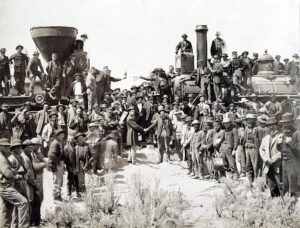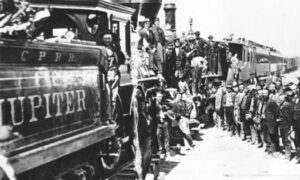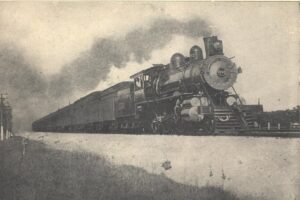 When people started moving west in the United States, the trips took approximately four months by wagon train. At that time, saying “goodbye” to loved ones was a very sad moment, because many times people would never see each other again. The distance was just too great and the cost too much, and unless people were moving permanently, they simply couldn’t take the trip. At that time…the 1860s, they likely had no idea that things would get easier either.
When people started moving west in the United States, the trips took approximately four months by wagon train. At that time, saying “goodbye” to loved ones was a very sad moment, because many times people would never see each other again. The distance was just too great and the cost too much, and unless people were moving permanently, they simply couldn’t take the trip. At that time…the 1860s, they likely had no idea that things would get easier either.
Nevertheless, just a short sixteen years later, all that changed. The train wasn’t a completely new invention in the 1860s, and in fact was invented in 1829. Still, as the United States was experiencing its expansion to the west, there were few towns and no railroads. So, moving west still meant that families might never see their departing loved ones again, and if the did, it would be a number of years. During the early 19th century, when Thomas Jefferson first dreamed of an American nation stretching from “sea to shining sea,” it took the president 10 days to travel the 225 miles from Monticello to Philadelphia via carriage. The distance from New York to San Francisco (which was founded in 1776, but didn’t become part of the United States until the signing of the Treaty of Guadalupe Hidalgo in 1848). Jefferson was president from 1801 to 1809. The distance from New York City to San Francisco is 2,565 miles from New York City, making the carriage time in those days approximately 114 days, or a little less than a third of a year. If you weren’t moving west, you would also have to make the return trip. It just wasn’t feasible.
Jefferson saw a possible answer to his dilemma as early as 1802, with “the introduction of so powerful an agent as steam.” At that time, he predicted, the possibility of “a carriage on wheels” that would make “a great change in the situation of man.” For Jefferson, the change would not come soon enough, and he never witnessed the  “carriage on wheels” he had envisioned. Nevertheless, within half a century, America would have more railroads than any other nation in the world, and by 1869, America would see the first transcontinental line linking the coasts was completed. Now, those journeys that were impossible for any reason but moving, that had previously taken months using horses, could be made in less than a week. In fact, on June 4, 1876, the Transcontinental Express train traveled from New York City to San Francisco in a mere 83 hours.
“carriage on wheels” he had envisioned. Nevertheless, within half a century, America would have more railroads than any other nation in the world, and by 1869, America would see the first transcontinental line linking the coasts was completed. Now, those journeys that were impossible for any reason but moving, that had previously taken months using horses, could be made in less than a week. In fact, on June 4, 1876, the Transcontinental Express train traveled from New York City to San Francisco in a mere 83 hours.
It seemed inconceivable that a human being could travel across the entire nation in less than four days. Nevertheless, now the impossible had become not only possible, but a reality, and the United States became a very mobile nation. Prior to that time, the coast were months apart, and it was speculated that the nation couldn’t possibly stay united. They couldn’t even communicate very well, much less see each other. Now, those problems were in the past. Just five days later, daily passenger service began. You simply can’t hold progress back. Once the technology is available, the reality isn’t far behind. Americans were amazed at the speed and comfort of this new form of travel. Of course, it wasn’t for everyone, because as with all new inventions, it was expensive and therefore, only for the wealthy. The train was luxurious, with first-class passengers riding in beautifully appointed cars with plush velvet seats that converted into snug sleeping berths. The finer amenities included steam heat, fresh linen daily and gracious porters who catered to their every whim. For an extra $4 a day, the wealthy traveler could opt to take the weekly Pacific Hotel Express, which offered first-class dining on board. As one happy passenger wrote, “The rarest and richest of all my journeying through life is this three-thousand miles by rail.”
A third-class ticket could be purchased for only $40–less than half the price of the first-class fare. At this low rate, the traveler received no luxuries. Their cars, fitted with rows of narrow wooden benches, were congested,  noisy and uncomfortable. The railroad often attached the coach cars to freight cars that were constantly shunted aside to make way for the express trains. Consequently, the third-class traveler’s journey west might take 10 or more days. Still, no one complained, because 10 days was far better than four months, and sitting on a hard bench seat was still much better than six months walking alongside a Conestoga wagon on the Oregon Trail. Of course, this amazing method of transportation would only be amazing for a short time in history, as trains gave way to cars and eventually airplanes. Still those things were either a way off, or would have to wait for the necessary roads and airports to make those forms of travel available. Trains were here now, and life was good!!
noisy and uncomfortable. The railroad often attached the coach cars to freight cars that were constantly shunted aside to make way for the express trains. Consequently, the third-class traveler’s journey west might take 10 or more days. Still, no one complained, because 10 days was far better than four months, and sitting on a hard bench seat was still much better than six months walking alongside a Conestoga wagon on the Oregon Trail. Of course, this amazing method of transportation would only be amazing for a short time in history, as trains gave way to cars and eventually airplanes. Still those things were either a way off, or would have to wait for the necessary roads and airports to make those forms of travel available. Trains were here now, and life was good!!


Leave a Reply